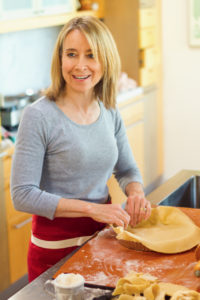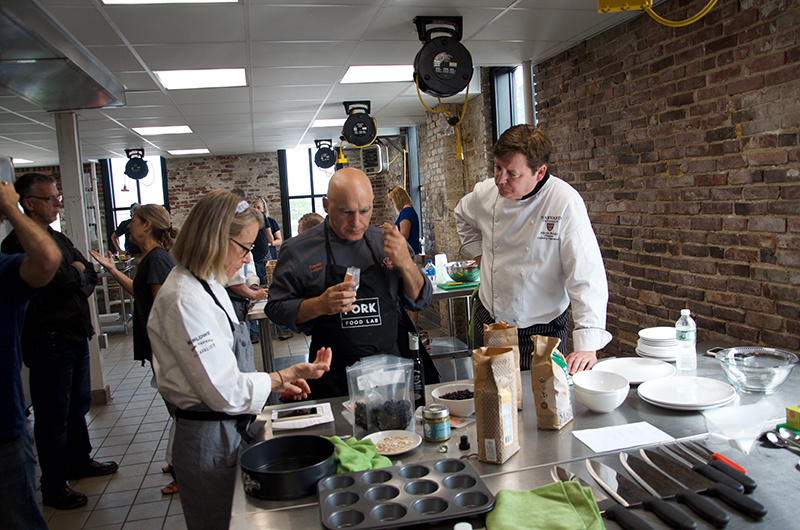Award-Winning Pastry Chef, Emily Luchetti, Weighs-in On Baking with Nature’s Best Ingredients
Emily Luchetti, author, restaurateur and pastry chef extraordinaire, has helped to define what great pastry in America means. In the 1980s, she found herself drawn into the food industry at a time when people were just beginning to pay attention to American regional food – a trend that remains prevalent in today’s food culture. Although she started her career on the savory side of the house, she found her passion in creating desserts. After eight years, she says, “I really didn’t enjoy working the line, peeling shrimp and garlic, and I decided I would rather work with chocolate, fruit and ingredients like that.”

When it comes to baking, Luchetti explains, for her, there is a smaller group of ingredients in the consideration set, whereas in savory cooking there is more all-out freedom. For America’s pastry chef, the essential flavor ingredients in baking are simple – they are chocolate, caramel, fruits and nuts. “I could wrap my head around them, and with a smaller group of ingredients, I felt way more creative,” she says. “My palate also matched well with creating desserts.” And today, the world agrees. She is known for combining ingredients in desserts that are different and interesting, but never too out there – a skill which has made the restaurants she is involved with rise in popularity and helped her to earn top recognition from her industry.
Fruits: Flavor and Performance Consistency
To create her delightful and tasty concoctions, Luchetti spends time visiting different parts of the country and local farmers markets to source the best ingredients for the restaurants where she is Chief Pastry Officer. Those include The Cavalier, Marlowe, Park Tavern, Leo’s Oyster Bar and Petit Marlowe all based in San Francisco and part of the Big Night Restaurant Group. In 2018, she visited Maine and experienced first-hand the natural growing setting of the Wild Blueberry barrens; tasted the tiny more potent berries directly from the field and cooked with different formats – frozen, fresh, dried and powdered Wild Blueberries – in an ‘Eating on the Wild Side’ Chef Challenge. Although Luchetti really believes in using seasonal fruit in her creations, she was surprised that the taste and nutrition of fresh and frozen Wild Blueberries were exactly the same.

“I think one of the best things about Wild Blueberries is that there are very few fruits that you can enjoy and work with year-round as a commercial pastry chef. “Wild Blueberries are one of those fruits, and they are an ingredient of such high quality. I love the consistency of that.”
Luchetti goes on to share that using Wild Blueberries all year long is a completely different experience than working with peaches or cherries from Chili or using frozen peaches in the winter. In her experience, those fruits are simply unusable in desserts because they lack flavor, are too watery and don’t react the same way their fresh counterparts do when mixed with the other ingredients in a dessert. “Flavor and ingredient consistency are critical to creating successful desserts on a large scale,” she adds. “I’ve found that the reason frozen peaches or cherries from Chili lack flavor is because those fruits have not been picked at their ultimate time or allowed to ripen into their ultimate time.” That is definitely not the case with Wild Blueberries,” she notes. And she’s right, Wild Blueberries are harvested at their peak of ripeness and individually quick frozen within 24 hours, providing food purveyors with a consistent Wild Blueberry flavor – akin to if they had flown to Maine and picked them out of the field themselves. “I love that even when Wild Blueberries are frozen you get what you get all year round in terms of flavor and performance,” she added.

Why Smaller is Better
Wild Blueberries are smaller in size than traditional blueberries because of the stressful environment where they grow and because they haven’t been modified to travel great distances. According to Luchetti, “there’s an immense benefit to that smallness when it comes to creating baked goods. I like that Wild Blueberries are smaller, because you can pack them in a muffin or cake allowing you to experience that hit of blueberry flavor throughout. It’s not like occasionally running into the flavor.” She continues, “If I tried to pack a muffin or cake with regular blueberries, they would create too much moisture and weight. Because the Wild Blueberry is small, you can disperse a lot more of them throughout your dessert. When you eat a blueberry muffin, you want that blueberry flavor in every single bite – or else you feel gipped – getting a blueberry every other bite – well that’s a bummer,” she acknowledges.
Advice for Pastry Chefs
For pastry chefs who haven’t used Wild Blueberries, Luchetti encourages them to do so. “They are easy to work with,” she says. “Pastry chefs can loosen up and have fun with them – because Wild Blueberries are so versatile, and you can do so much with them and they go with so many things – like coffee cake with ground up coffee, caramel and white chocolate – and they pair well with dark chocolate, lemon and lime flavors, too.”
Luchetti does offer a quick tip. She says, “Because Wild Blueberries are found predominantly frozen, you’re working with a little wetter fruit, but all you have to do is drain them and mix them with a tiny bit of flour. I’ll go back to my muffin example – you’ll want to take that step to prevent the berries from sinking to the bottom. Fruits in general sink because they are watered down and who wants them all at the bottom. So that trick I shared with the muffins is really, really crucial with other larger fruits, but because the Wild Blueberries are smaller with a higher pulp to skin ratio and have less water in them, even when frozen, than regular blueberries, it’s less of a problem, but dusting with flour still helps.
As she sits at her desk in her office staring out the window at her lemon tree, Luchetti says, “The best thing about working with Wild Blueberries is that there’s not a lot of prep time and you can use them all year round. She says the reaction by customers to her new menu items featuring Wild Blueberries has been really great. They think they are delicious.”


